Name
The Polish name of the city is Wrocław, remember that the [ł] is more pronounced like a "w". The name derives from the old word Wortizlawa. At least as old as the Polish name is the German name Breslau, but Silesians also called it Preßlau and Prassel. To make things complete, there's also a Czech name for the city, which is Vratislav. All of these names sound similar for a good reason - they all derive from the Bohemian Duke Vratislav I..
Location

| ||
| Wrocław/Poland |
Wroclaw lies in the beautiful southwest corner of Poland and is around 400 km away from the capital →Warsaw. To the German border it's around 180 km, to the border with the →Czech Republic less then 100 km. The town marks the centre of the Województwo Dolnośląskie (Voivodeship Lower Silesia), which covers the entire Southwest of Poland and was ruled by Germany for a very long time. Wroclaw is crossed by the river Odra (German: Oder), which has an extensive network of distributaries in and around the town. The Karkonosze Mountains in the Southwest are around 80 km away and can be seen from Wroclaw's churches on clear days.
Population
With some 640,000 inhabitants, Wroclaw is by far the largest city in Lower Silesia and the entire southwest of Poland. It's also the fourth largest city in Poland - which is hard to believe when looking around in the old town centre.
Orientation
Wroclaw has an amazingly clear layout of streets. The centre itself stretches between the river Odra in the north and the railroad in the south. The largest part of the city occupies the left (southern) bank of the river, which has many islands around the town. From the Wrołlaw Główny (main train station) it's around 1.5 km northwards to the river. Stare Miasto (The Old Town) itself is surrounded by parts of the old river system and some parks - therefore it's easy to find. The egg-shaped old town or historical centre is only around 400 m long. The centre of the old town again is marked by the Stary Rynek (Old Market). Several bridges cross the river in the north, leading to two important islets - Sand Island and Cathedral island (see below for more information). Almost all important sights of Wroclaw concentrate in the old town and those two islands, so everything is within walking distance. However, the newer district between the old town and the train station is well worth a visit, too.
History
The town was already mentioned around the year 900 for the first time. It was probably founded by the Bohemian Duke Vratislav I, whose name was to be used for the town from then on. At the beginning, the town developed around Cathedral Island north of the present-day old town. Around the year 1000, the duke's castle was built. And it became the centre of one of the three Polish dioceses. Since then, Wroclaw was about to remain the centre of the ever since rather rural area of Lower Silesia, which later split from the rest of Poland.
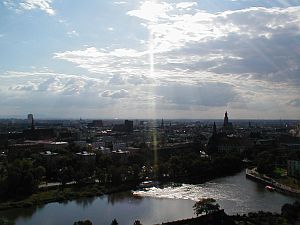
| ||
| View from the Cathedral across the river Odra |
As a result of royal succession policy, Wroclaw fell to Bohemia in 1327 (see also →Czech History), but nevertheless it became a member of the mighty Hanseatic League. Despite several catastrophes, Wroclaw developed into a thriving trade centre. From the year 1526 on, Wroclaw was ruled by the Habsburg Monarchy, which shouldn't change until the year 1742. After that, Wroclaw and the rest of Silesia became part of Prussia. And so Silesia and Wroclaw were later inherited by Germany - Wroclaw was in line with many other large German towns such as Hanover, Stuttgart or Königsberg (present-day Kaliningrad in Russia). It's role as the cultural, industrial, scientific and administrative centre of Lower Silesia has been unchallenged since then.
It was 1944 when Wroclaw suffered first massive air raids. In 1945, the Red Army rapidly advanced westwards and surrounded the town completely in February. However, advancing towards Germany was more important then taking the town in a bloody battle, and so the Red Army left Breslau - as it was called at that time - aside. Already in 1944, Wroclaw was declared "fortress (town)" in 1944. By definition, a fortress was a place that must not be surrendered no matter how overwhelming the enemy is. Therefore, the Wehrmacht and the Volkssturm (German militia set up during the last months of the Third Reich, consisting mainly of children and elderly) did everything to defend the town. Only on the 7 May 1945, one week after Berlin fell and one day before the capitulation, Wroclaw surrendered. The price for the long resistance was high - more then half of the town was in ruins, ten thousands of citizens had lost their life.
Wroclaw was rebuilt after the war - and the result is nice to see. Since 1990, the German heritage of the city is being taken more and more into account. Nowadays, Wroclaw aka Breslau is a cosmopolitan, open-minded city. In 1997, the devastating Odra flood brought a lot of damage to the town. However, since the ancestors knew where to build to avoid floods, almost nothing of the historic buildings were damaged. But the flood hit newer districts along the river hard.
Getting there / transportation
It's possible to get to Wroclaw by plane, but most flights would be via Warsaw. When going by train, it takes almost 5 hours to and from →Warsaw - the ticket costs little less then € 10. There's a daily train to →Prague, which takes 5½ hours. Another daily train runs to Berlin (6 hrs) and continues to Hamburg (9 hrs). Another way to proceed westwards is a local train to the Polish-German border town Zgorzelec/Görlitz (3½ Stunden). Other trains run northwards via →Poznan all the way to the Baltic Sea.
City transportation includes trams and busses. But since the centre is very compact, short term visitors won't need to rely on them.
Most travellers arrive at the main train station, which is, judging on the interior, definitely not the most modern train station in Poland. But from outside it's a marvellous building, resembling Schinkel's famous architecture. The train station was already built in 1850. From the train station, it's only around 100 metres straight forward to Piłsudski street. There, turn left and walk a few minutes to the Holiday Inn. There, turn right into Świdnicka Street. This street leads to the somewhat unattractive Kościuszki Square. From there, it's a few minutes only straight ahead to the absolute centre of town - the Old Market Square.
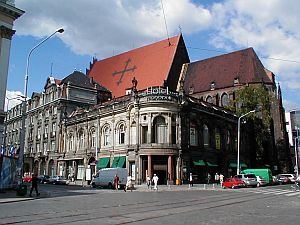
| ||
| The fine hotel Monopol |
The Podwale (Wall moat) surrounding the old town is a nice green belt with its parks and parts of the old Odra riverbed. Along the park runs a busy street with the same name. When coming from the train station, the Opera lies on the left side. On the other side of the street, there's the beautiful although somewhat run down Hotel Monopol - a marvellous art noveau building from the end of the 19th century which has it's certain charme because it's run down (but this might have changed by the time you read this). Right behind the hotel you can see the roof of Kościoł św. Doroty (St Dorothy Church) a gothic church from the 15th century. From there it's only a few hundreds metres along one of the main shopping streets to the centre, called Stary Rynek (Old Market).
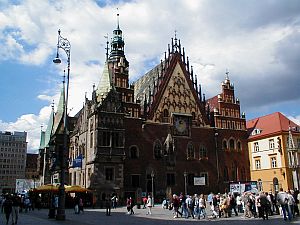
| ||
| The Town Hall of Wroclaw |
Old Market, the central square, is nothing less then Poland's second largest old town square (the biggest one of course is in Krakow). The middle of the square is occupied by a block of small and very small houses, lining along tiny alleys. Some of the houses are now used as restaurants and bars. In front of this beautiful scenery stands the splendid Ratusz (Town Hall). It took a good deal of time to finish this late-gothic building - construction started in 1290 and was finished in 1504. But during that time, parts of the building were often changed or rebuilt. Fortunately, the town hall survived the Second World War without disastrous damages. Today it houses the Historic City Museum of Wroclaw.
Next to the Old Market starts the smaller pl. Solny (Salt Square). Right at the corner between the two squares lies the tourist information.
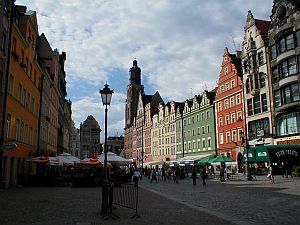
| ||
| Beautiful ensemble alongside the Old Market Square |
Almost all old buildings around the Old Market and in many other parts of the inner city have been restored in a nice way and form a distinctive architectural cocktail - not all buildings date back to the medieval age. Here and there are some art noveau buildings and also much younger, but less attractive buildings. However, Wroclaw managed to keep its unique charme. As soon as it gets reasonably warm, most cafes and restaurants put out their chairs and tables, inviting to sit down and relax. Still it's hard to believe that this town has much more than half a million inhabitants - the old town makes it appear much smaller.
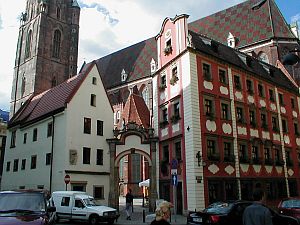
| ||
| St Elisabeth Church |
The north-west corner of the Old Market is characterized by the eye-catching, colourful roof of k. św. Elżbiety (St Elisabeth Church). This gothic building was started to be built around the year 1330. Its 83 metres high tower is a landmark of Wroclaw. Particularly interesting are the two tiny houses in front of the church - they are known as Jaś i Małgosia (the Polish version of Hansel and Gretel). As it can be seen on the picture above, both houses are connected by a baroque arch.
There are many, many other churches in Wroclaw - Catholic and Old Catholic, Evangelic and Ukrainian-Unified (Eastern Catholic), large and small, old and new churches. Churches spread all over the old town. There's also a Synagoga in the southwest part of the old town not far from the pl. Wolności (Freedom Square). The latter is often used as an open air market place.
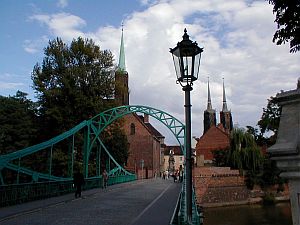
| ||
| On the bridge to Cathedral Island |
Walk along Kuźnicza Street from the Old Market to the north, and it's only a few hundred metres to the river Odra. To the right, several churches and the university campus line up along the river. The largest of those churches is the gothic k. św. Wincentego (St Vincent Church). Dating back to the 13th century, this church is used by the Ukrainian-Catholic community. Behind the church there's a small bridge leading to ostrów piasek (Sand Island), which is - surprise! - known for its churches. The island is really small but large enough for two churches. From there, another bridge leads to o. Tumski (Cathedral Island). As mentioned above, this island is the place where the history of Wroclaw began.
As the name already suggests, the island is home to a cathedral - to be exactly the Ostrów Tumski katedra (Cathedral Island Cathedral) - this name defintely makes sense. Technically, this island hasn't been an island anymore for a long time, since many years ago the northern creek of the Odra was filled and dried out. Construction of the cathedral started in the 13th century, but it took until 1590 to complete the structure. One of the main characteristics of the cathedral are the twin towers, which were rebuilt in its present form in 1991. An elevator lifts up the lazy visitor to the observatory platform for 2 Zł. From there it's a splendid view over the entire town. Besides the cathedral there are four more churches on the small and quiet ex-island.
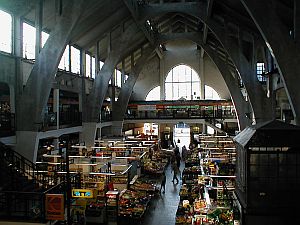
| ||
| Inside the market hall |
The northern and the eastern part of the old town inside the ring are less interesting, but they feature several parks, mainly near the river, and many more churches, so it's another nice area to simply stroll around. Among other things, there's also an old-fashioned market hall which is still in use. To cut a long story short - Wroclaw is a real juwel and getting more and more attractive. A clear sign for this are countless coach parties - mainly retirees - flocking around in the old town.
As mentioned above, the Karkonosze Mountains in the southwest are not too far away. A nice destination there is a small town called Karpacz (German name: Krummhübel) at the foot of the famous 1,602 metres high Śnieżka (German name: Schneekoppe). Karpacz is famous for winter sports, but it also sports another, unusual attraction: Wang Church. This Norvegian, wooden church was built in the 13th century and - for unknown reasons - shipped to Karpacz during the 19th century. Busses run between Karpacz and Wroclaw.
Not a bad choice is the old, conveniently located Hotel Savoy at Kościuszki Square, halfway between train station and old town. Rooms are okay and have private bath rooms. A double costs € 25, and it's worth the money. Address: Plac Kościuszki 19, Tel.: 071-344 3071.
- www.wroclaw.pl: Official, multilingual website of Wroclaw. Well done website with plenty of information.
Do you have or do you know a good website about Wrocław? Don't hesitate, let me know! After checking it, I would love to add it to the link list. You can submit a link by using the →contact form. Note that commercial websites will be treated differently.
©2024 Europe-East.com

 Albania
Albania Poland
Poland